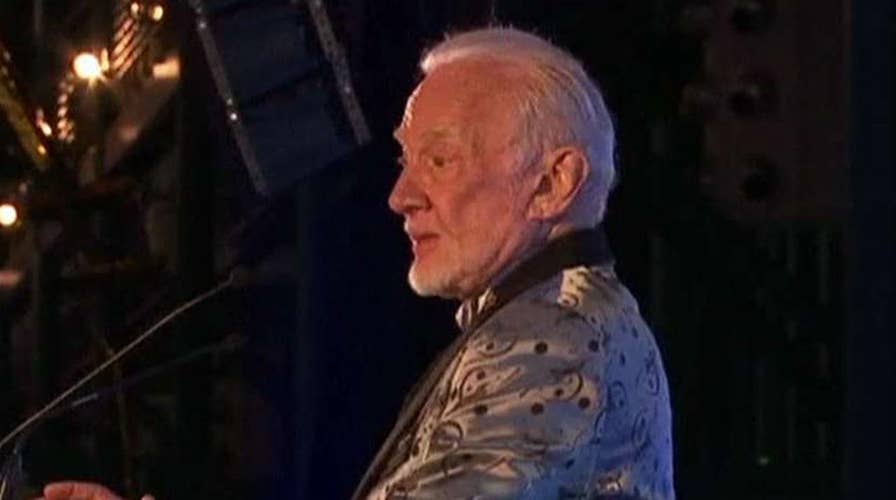Buzz Aldrin, the second man to walk on the moon, has pushed for humanity to expand its presence in space, making Mars habitable for mankind. But for a planet whose atmosphere is almost entirely made up of carbon dioxide, how will humans do something as simple as breathe, much less live?
Speaking with Fox News, Aldrin said there may be feasibility to ideas put forth by tech luminaries such as Elon Musk (a friend of Aldrin's), including detonating nuclear weapons as a way to 'terraform' the Red Planet or transforming Mars so it can support human life.
"Well, he’s not the only one who's pioneered ideas like that," Aldrin said in an interview with Fox News. "He’s a little more flowery with things he does, but there's also Richard Branson and Jeff Bezos, the latter of whom I have great admiration for and the slow steady way he’s limiting himself to lunar industry that will then enable the same for thousands and millions of people."
BUZZ ALDRIN:HOW WE CAN MAKE MARS MISSIONS A REALITY
The 88-year-old Aldrin went on to say that much of humanity knows we need to get to space to survive, even if the cost for expansion into space is currently, pun intended, astronomical.
"There's this thing up there called the moon, and it’s caught our fancy," the former astronaut and Command Pilot in the United States Air Force said. "And it’s time to begin to exercise what we’ve learned in a way that we can do at the moon, and share the cost - very important. The U.S. can’t pay for all of this, we've got to share the costs and share the benefits so that we directly contribute to just what we are able to do."
He continued: "And its gonna be much greater than two guys for one day, there months later, something like that. We’re gonna occupy the moon, and we’re going to think about occupying but, I think we’re going to settle Mars."
Aldrin has previously told Fox News he believes astronauts could land on Mars by 2040.
The Apollo 11 astronaut is in the spotlight at the moment after filing a lawsuit against two of his children over control of his estate and space artifacts.
Drop a bomb
In 2015, speaking with "Late Show" host Stephen Colbert, Musk said that terraforming Mars could be done by dropping thermonuclear bombs on the poles or releasing greenhouse gases to warm up the planet. Colbert joked that Musk might be a super-villain.
Others have come up with more conventional ideas, including NASA, which proposed launching an enormous magnetic shield into space to protect the planet from solar winds in a 2017 paper.
BUZZ ALDRIN REMINDS US HE TOOK THE FIRST SPACE SELFIE ON #NATIONALSELFIEDAY
"The magnetic field direction could also maintain an orientation that keeps it parallel with the impinging solar wind interplanetary field thereby significantly reducing mass, momentum, and energy flow into the magnetosphere and thus also damping internal magnetospheric dynamics," the NASA paper reads.
"This situation then eliminates many of the solar wind erosion processes that occur with the planet’s ionosphere and upper atmosphere allowing the Martian atmosphere to grow in pressure and temperature over time."
NASA has also proposed making oxygen from Mars' atmosphere, using an experiment known as MOXIE, which would involve converting the enormous amounts of carbon dioxide found in the Red Planet's atmosphere.
Life on Mars?
Mars' atmosphere is 95.97 percent carbon dioxide, 1.89 percent nitrogen, 1.93 percent argon, 0.0557 percent carbon monoxide and just 0.146 percent oxygen.
By comparison, Earth's atmosphere is made up nitrogen (78.09 percent), oxygen (20.95 percent), argon (0.93 percent), carbon dioxide (0.04 percent) and small amounts of other gases.
NASA UNVEILS BOLD NEW PLAN TO PROTECT EARTH FROM ASTEROIDS
It will be years, perhaps even hundreds of years, before Mars is made habitable for humans. No matter how it's done, Aldrin believes now is the time to capitalize on humanity's interest and make it a reality.
"It’s going to take a lot of analysis, a lot of weighing the option, about how significant this is to excite the public and treating the crews," Aldrin said. "Of course there is a great economic benefit of going up but [also] pay the cost of bringing people back."
Follow Chris Ciaccia on Twitter @Chris_Ciaccia

